Menu
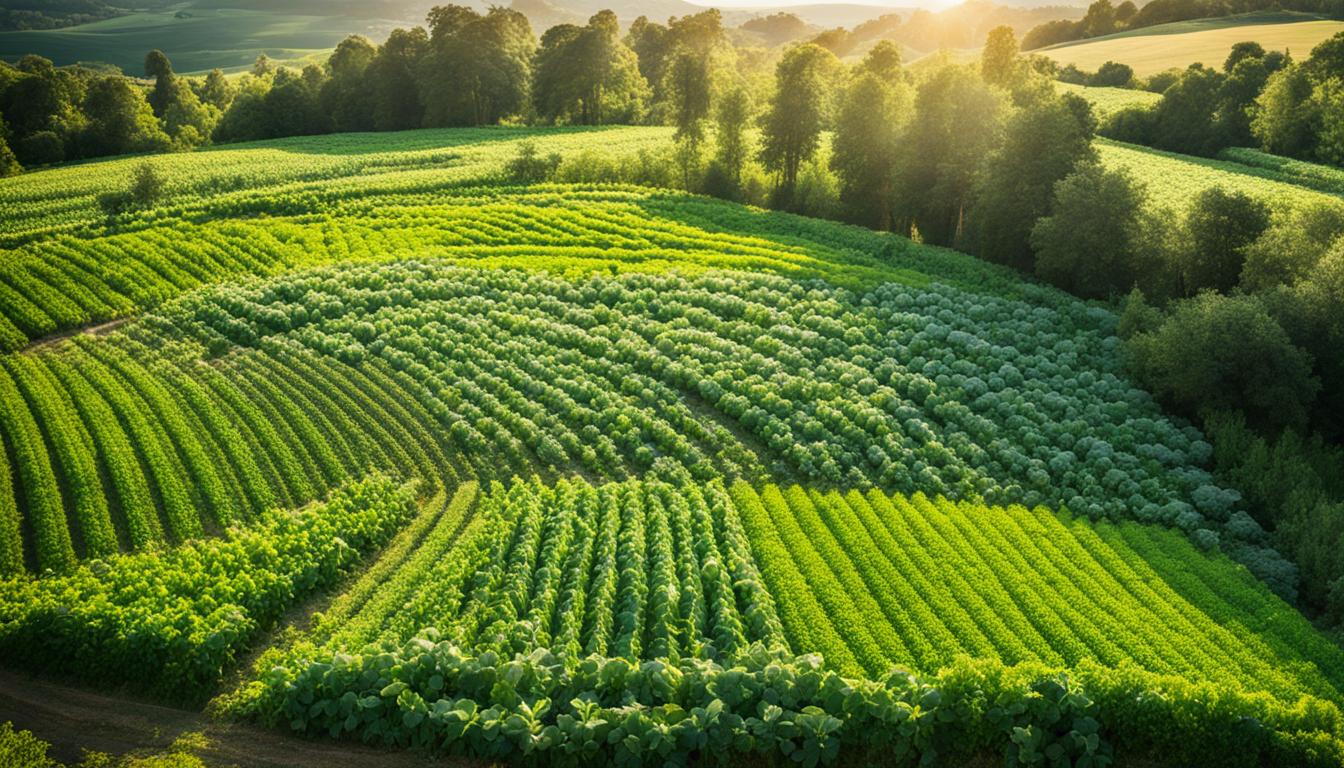
As I walked through the fields at Singing Frogs Farm in Sonoma County, I was amazed. There were red-legged frogs croaking and pollinators buzzing. All this life showed me how important diversity is in farming. The farm had changed thanks to regenerative farming. In six years, the soil was much healthier. They also planted 3,000 new plants for pollinators. This proved how powerful biodiversity is in farming.
It’s hard to believe that 86% of Earth’s species are still unknown. But even on one ranch in California, they found 157 different plants. This shows how important and rich biodiversity is. It helps the environment work well. The mix of animals grazing and many plants on the ranch balance the ecosystem.
Farmers and scientists are learning more about how biodiversity helps farming. The work at Singing Frogs Farm is a great example. They do a lot, like planting many different crops and supporting good bugs. This helps their crops grow well and keeps the environment healthy. Biodiversity is key for farming that lasts and is good for the planet.
Biodiversity is crucial in farming. It brings a lot to the table in various ways. These include better soil, more crops, and fewer pests. It all starts with having many types of plants and animals around.
Biodiversity is key for soil health and nutrients. A mix of plants and animals underground keeps the soil lively. This helps nutrients move around and makes plants stronger. Things like changing crops and using compost can really boost the land.
Pollination is at the heart of farming, and biodiversity makes it happen. Bees and other pollinators are vital. But they’re in trouble because of farming’s chemicals. We’re seeing fewer and fewer of them, which is worrying.
Pest control is another plus of having lots of different life forms on the farm. Good bugs and birds keep the bad pests away without using chemicals. But big farms that grow only one thing don’t have enough of these good guys. It pays to keep a variety of plants and use smart pest control methods.
| Statistic | Impact on Biodiversity |
|---|---|
| 8.7 million species exist on Earth | Provides a broad genetic pool for resilient farming systems |
| 80% of deforestation due to agriculture | Leads to loss of habitat and reduction of biodiversity |
| 100,000 square miles of deforestation annually | Equates to habitat destruction approximately the size of the UK |
| 2.5 million acres of grassland converted to cropland (2015-2016) | Reduces native biodiversity and destroys ecosystems |
In the end, protecting biodiversity matters a lot in farming. It’s all linked. From healthy soil to fruitful crops and fewer pests, it shows us how everything is part of a big cycle. This helps farming thrive and promises a greener future.
Today, caring for our planet is vital. That’s why sustainable farming methods are so important. Conservation tillage and cover crops are two key methods. They help reduce soil loss and cut down on farming’s carbon footprint.
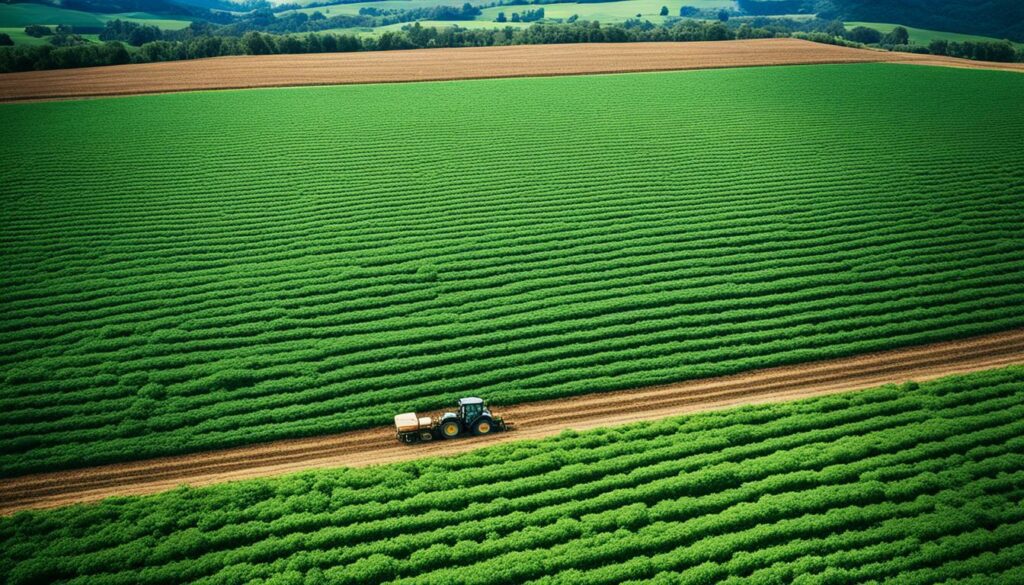
Conservation tillage keeps the soil laid down. This helps keep the top layer of soil strong and stops it from washing away. Using too many herbicides has made some areas less diverse. But, conservation tillage makes the soil more alive. This way, it fights soil loss. This is critical in places like the U.S., where a lot of grasslands have turned into farm fields.
Cover crops, like rye and radishes, are vital for sustainable farming. They help keep the soil healthy and attract wildlife. This boosts the variety of life near farms. With fewer pollinators, like the drop in monarch butterflies, their role is more important. Plus, cover crops lock up carbon and nitrogen in the soil. This is a big step towards farming that helps the planet.
Together, these farming methods are key to facing our environmental issues. They lead to a healthier planet and soil. This is better for everyone.
Ecological diversity in farming is key to supporting many different species. This happens by mixing various habitats in farming. This creates places where lots of life can flourish. Scientists think there are at least 8.7 million different species on the Earth. So, diverse farming helps a huge number of plants, animals, and other living things.
Turning grasslands and forests into farmland affects habitats a lot. For example, tallgrass prairies in the US have mostly disappeared. In about 150 years, 99% of them have been lost due to farming. Also, from 2015 to 2016, 2.5 million more acres of grassland became cropland. This causes major habitat loss and less diversity for farming.
Monarch butterfly numbers have dropped by 70% in recent years. This shows how important it is to keep diverse habitats in farming. Pesticides and herbicides used in farming hurt not just butterflies, but bees, fish, and birds. Farming also shrinks the variety of wild plants near farms. This change disturbs local ecosystems and the animals that live there.
Clearing forests for farming harms global biodiversity a lot. Nearly 100,000 square miles of forest disappear each year. Agriculture causes 80% of this destruction. The Amazon rainforest, which houses a quarter of all land species, faces a big threat. Farming these areas upsets the broad network of life needed for good farming.
We can help by making spaces that welcome a lot of different life. We should aim for more trees, less turning over the soil, and using fewer chemicals in farming. These methods boost farming’s strength against harm. They also use the Earth’s resources in a better way.
Embracing diversity in farming, like mixing trees with crops or growing many plants together, boosts the health of the land and helps farms produce more. It’s a smart way to manage the land that uses resources well and keeps the environment in balance.
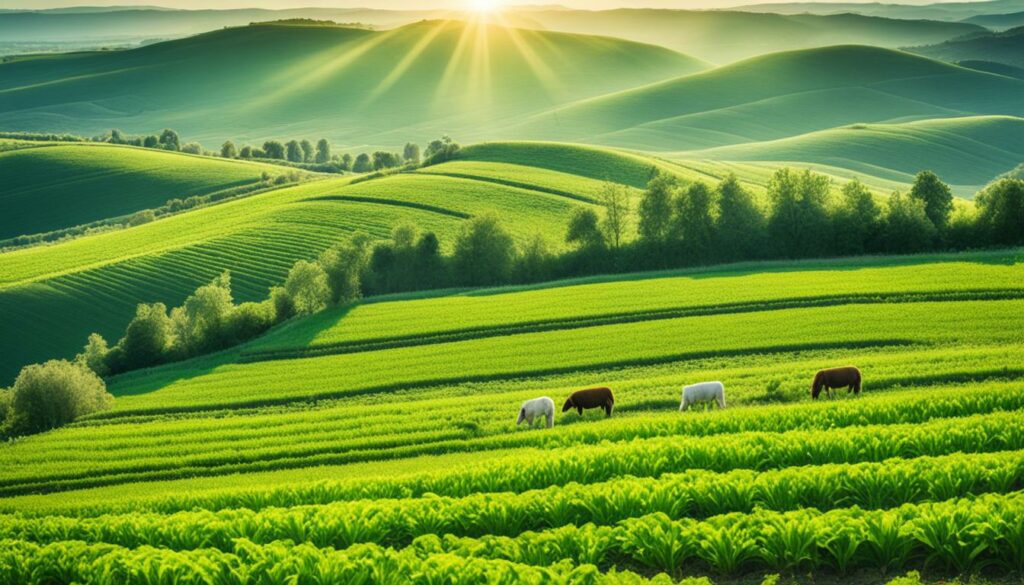
Agroforestry mixes trees and bushes with crops and animals, increasing the variety of life around. This richer environment helps the soil and farms become more stable. Such farms are usually of medium size and are run well, giving the farmers what they need to succeed.
Polyculture means growing many crops together, which naturally fights off pests and benefits the soil. It stops any single crop from taking over, making the farm’s life more diverse. But, not many small farms can try this due to a lack of money.
Using both agroforestry and polyculture can be a great way to farm. It’s not just good for the earth, but it also helps farmers sell their products at better prices and be more independent in their work. Governments can help through programs like the Healthy Soils Program, but they need to do more to get farmers to join in.
Farmers with land parcels of 20 to 350 acres have it best; they have secure land and funds to do varied farming. This allows them to fully benefit from diversity in farming.
But, bigger farmers can find it harder to change how they farm due to what the buyers want and market rules. These rules are often about food safety and customer preferences and tend to limit change. Still, with the right support from policies, all farmers can find ways to make their lands more diverse and resilient.
Trying to boost wildlife variety in farms helps keep nature’s balance. It makes farms stronger too. For example, creating specific areas on farms gives many animals a safe space to live. This includes small bugs all the way to big animals. Making hedges also helps by giving a home to creatures that eat pests.
Our planet has over 8.7 million different kinds of life. They all matter for our world to work right. But, making more farms has destroyed their homes. Take the tallgrass prairies in the US, they’ve shrunk to just one percent of what they were. And in just a year, we lost 2.5 million acres of grassland to farming.
Adding hedges and saving wild spots on farms can help. It’s good for making homes for animals and letting natural pest killers thrive. We need to protect wild places as farming grows. Sadly, farming is now the top reason forests get cut down. We lose about 100,000 square miles of forest every year this way.
Farming too much with chemicals hurts plants and animals. For example, a weed killer called glyphosate is bad for wild plants near farms. And some insect killers make it hard for bees to live. They can’t help plants grow, which is bad for us all.
To truly help wildlife, we need smart ways to farm that keep the land and nature healthy. Adding small natural areas around fields has good results. It helps many bird types and makes farming better for the future.
| Challenges | Measures | Benefits |
|---|---|---|
| Habitat Loss | Implementing Hedgerows | Enhanced Predator Support |
| Pesticide Use | Conserving Wild Areas | Natural Pest Control |
| Biodiversity Decline | Creating Diversified Habitats | Increased Species Diversity |
| Soil Disturbance | Reducing Herbicide Use | Improved Plant Diversity |
Collaborative efforts between researchers and farmers are vital in demonstrating the benefits of alternative farmland management practices such as higher crop yield and improved soil quality.
Conserving the environment on farms is key for keeping biodiversity alive. With so much land used for growing food or raising animals, it’s important to also save places for wildlife. This helps the whole ecosystem work better.
To keep habitats intact, farmers should leave some areas untouched and control how much animals graze. About 10-20% of land is used for extensive grazing. In the UK, 75% of the farmland is supporting different plants and animals. This work benefits over a billion people who live near unique wildlife areas.
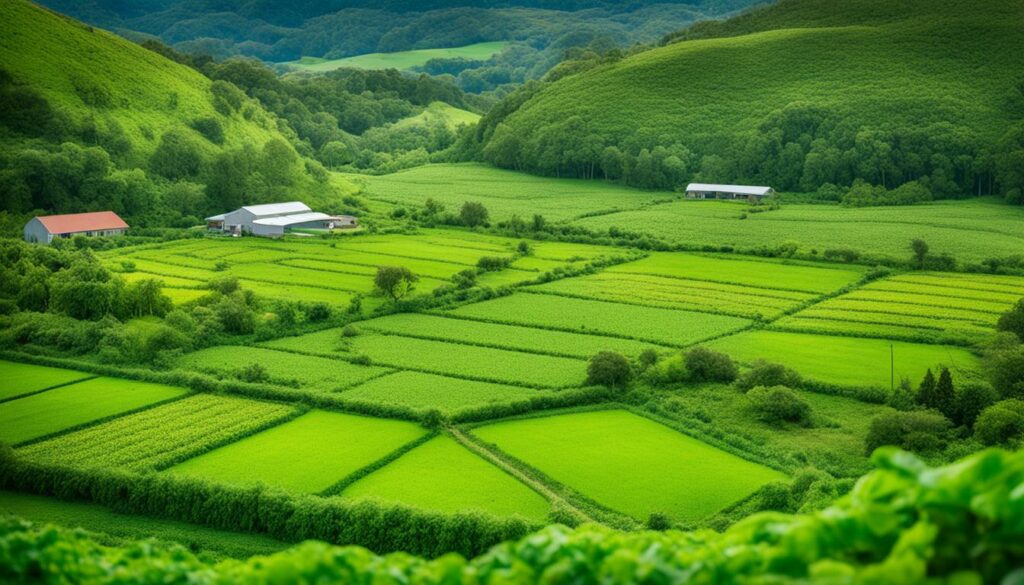
Looking after water well is a must for healthy ecosystems. Farms use a lot of water, so saving it with special systems is important. Using these systems can also help stop chemical pollution that harms our oceans. So, good water practices help protect habitats and the environment.
Evidence shows that old farming ways don’t help save nature space. But, new methods like bringing back lost habitats can cut costs for farmers and help the environment. By doing this, farms can produce more food and be ready for the future, like coping with climate change.
Enhancing biodiversity in farming means more than just growing crops. It involves using a variety of living things, from big plants to small microorganisms. This approach helps make farms both more productive and stable. It also makes them tougher against pests and diseases.
There are many strategies to bring in more species. One technique is called conservation tillage. It keeps the soil mostly covered with crop leftovers. Another is no-till farming, which disturbs the soil less. This helps create a good home for friendly microorganisms and improves nutrient recycling. Diverse plants, used in crop rotations and as cover crops, help the land stay healthy and avoid depletion.
Farming that mimics nature is beneficial. It keeps pests away and strengthens the land’s defenses. Such methods are good for the environment and the farmer’s wallet, especially in niche markets.
Adding organic matter to the soil is also key. It’s full of helpful microbes that boost soil health. These practices make the farm more resilient. They also reduce pollution and keep soil from washing away.
Technologies like GPS can make farming more efficient. They reduce the need for harmful chemicals. Protecting genetic diversity is also important. It ensures our farms can adapt to a changing world.
| Technique | Benefit |
|---|---|
| Conservation Tillage | Maintains soil coverage, reduces erosion |
| No-Till Farming | Minimal soil disturbance, supports microorganisms |
| Crop Rotations | Prevents soil depletion, increases species richness |
| Organic Matter Addition | Improves soil health, aids nutrient cycling |
| Buffer Strips | Reduce erosion, filter pollutants |
Using these strategies, farmers can balance production with conservation. This approach leads to a sustainable food system. It also helps keep our planet diverse and healthy for those who come after us.
Biodiversity brings many good things to farms. This includes helping economically and environmentally. Using biodiversity well can make farms more profitable and better for our planet.
Biodiversity boosts profits for farmers. It helps crops grow better without needing lots of chemicals. For example, rotating crops and adding organic matter to the soil boosts nutrients and its structure.
Different crops and planting methods also mean less need for pesticides. This saves money and makes farming better for the environment. It can also help farmers find special markets, making their business more flexible and less risky.
Adding diversity to farms is great for the earth. It helps store carbon, which fights climate change. Using varied crops and not tilling too much helps soil stay fertile and absorb carbon.

Mixing crops also helps with water. Farming uses a lot of water, which will only increase. But farming in diverse ways helps keep water in the ground and not waste it.
Also, diversity in farming stops nature from being destroyed. Most of the world’s forests are cut down for farming, which hurts species like the monarch butterfly. Using biodiversity on farms can help keep their homes safe.
Putting the earth first can also mean more money for farmers. Biodiversity in farming leads to longer-lasting success. It balances making profits now with leaving a healthy planet for future farming.
| Category | Advantages |
|---|---|
| Economic | Improved crop yields, reduced use of pesticides, niche market opportunities |
| Environmental | Carbon sequestration, enhanced soil fertility, better water management, habitat preservation |
I’ve looked into the rewards of biodiversity in farming and found many case studies. They show how different countries approach and succeed in regenerative agriculture. These success stories come from places like Canada, India, China, Brazil, Kenya, and the United States.
Over 76 reports show great progress in regenerative agriculture and adaptive management. They focus on topics such as the importance of pollinators, soil life, ways to farm sustainably, and steps to protect nature.
The FAO and UNESCO, along with various government bodies, have shared their research. For example, a study in India looked at how using Azobacter improved soil. In Canada, researchers checked out pollinator diversity in farms. In Vietnam, they checked how well those involved in the Siam benzoin trade looked after biodiversity.
Success stories also include making rice fields more productive and using local plants for chicken homes. They prove that blending old farming knowledge with new ideas is a recipe for success. This mix is key in making sure farming practices consider a wide range of plants and animals.
The reports dive into topics like growing organic chilis in Vietnam. They also examine the benefits of using Indian Prickly Ash in Lao PDR. These efforts not only help nature but also meet international laws and share profits fairly. The stories also point out how smart farming can bring better lives to farmers and their communities.
| Country | Case Study | Focus |
|---|---|---|
| India | Azobacter Utilisation | Soil Health |
| Canada | Pollinator Biodiversity | Pollination |
| Vietnam | Siam Benzoin Supply Chain | Biodiversity Conservation |
| Vietnam | Organic Chili Production | Biodiversity Contribution |
| Lao PDR | Indian Prickly Ash | Conservation and Legislation |
| Myanmar | Jujube Production | Sustainable Practices |
Moreover, many case studies show that being flexible and using regenerative agriculture can better the natural world’s services. They lay out a path that farming should follow in the future. These studies highlight the real gains of making nature a big part of farming. This pushes for more worldwide interest and support for nature-friendly farming.
Integrating biodiversity in farming is hard because of money issues and not knowing its benefits. Farmers need to know how helpful biodiversity is for farms. They also need help to make this change easier.
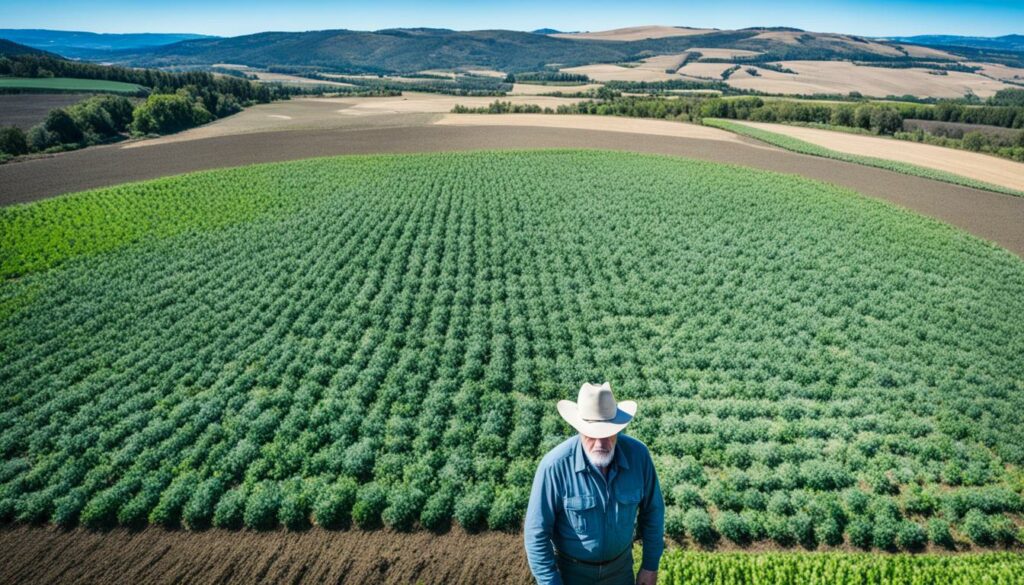
Money is a big issue for anyone wanting to farm with biodiversity in mind. The start-up costs are high. Yet, old ways of farming have harmed the planet a lot. This hurts our world but is also hard for farmers to change from.
They often can’t afford new methods. Plus, traditional farming leads to too much nitrogen in the environment. This makes farmers keep using harmful old ways.
Many don’t understand how important biodiversity is for farming. New technologies seem helpful, but environmental problems continue. Progress is slow, especially in Europe, on things like less greenhouse gas and water pollution.
People, especially at the farming level, don’t fully know how bad traditional farming is. This farming can destroy landscapes and reduce places where plants and animals can live. Such spots are vital for our planet’s health.
Increasing knowledge and offering money help must happen to solve these problems. We need to make people aware and help them financially. This way, farmers can move to methods that are kinder to the earth. With these, we can support our farmers better.
Government policies play a key role in aiding biodiversity on agricultural lands. These lands are vital, covering about a third of the world. Policies that support nature are essential. They can help fight the loss of plants and animals living in these areas due to farming practices.
Farmers are being encouraged to protect wildlife by these tactics. They get help, like subsidies, to keep their farms eco-friendly. This is crucial for the over 1.1 billion people worldwide living where biodiversity is rich. Since their lives depend on farming, it’s vital that policies are smart and make a real difference.
Using too many chemicals in farming is a big issue now. It’s bad because the damage these do is more than what nature can fix. So, policies must stop harmful farming practices. Steps include better controls to fight pollution and to save natural lands from harm.
We must also give subsidies that encourage saving nature, not just for farmers’ profits. With the world’s population growing and needing more food, we can’t forget nature. This is even more important as people are eating more meat. Policies must encourage better ways to produce food.
The EU and the US are already leading by spending on new farming solutions and nature-friendly projects. For example, they’re investing in new technologies to better use land. Their goal is to protect a lot of land and water by 2030 for everyone to enjoy. It’s all about smart policies that help both farming and nature.
Financial help from countries like the US to global environmental groups is also a big deal. It shows that countries can work together to save nature. This support and smart policies can help us all enjoy a greener, safer world in the future.
Biodiversity and farming are changing fast, thanks to new developments and teamwork around the world. These future trends are set to change how we farm, boosting both production and nature’s harmony.
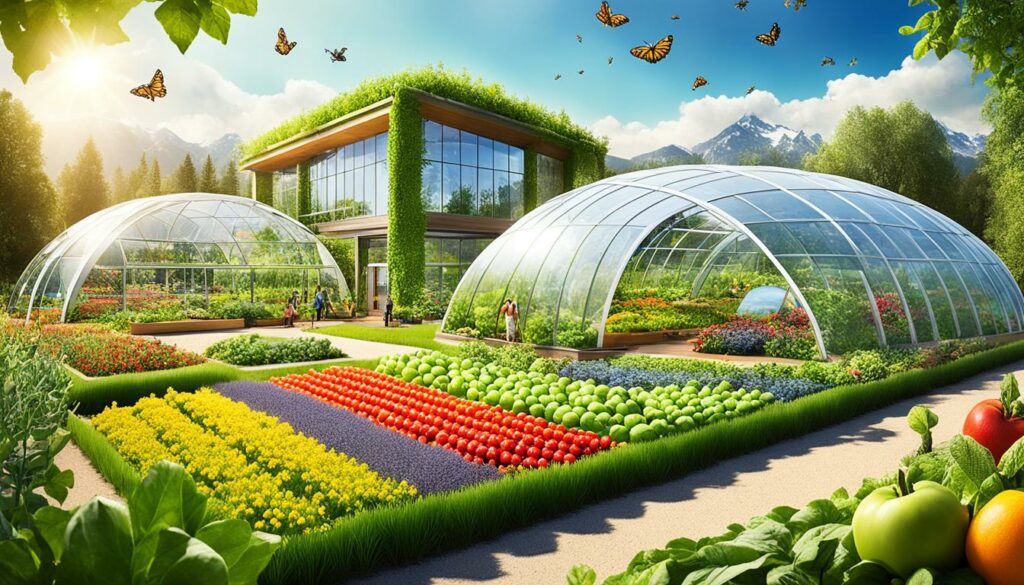
Precision farming is at the forefront of technological innovations. It uses advanced tools and data to make farming more efficient and friendly to nature. Take, for example, monitoring soil health precisely, which cuts down on harmful chemicals, making crops healthier. Also, using less fuel for tilling the land can greatly cut the carbon pollution of farming.
Global biodiversity initiatives bring countries together to solve farming and nature challenges. Costa Rica, for instance, leads by example with its PES scheme, aiming to grow protected forests and encourage eco-friendly farming. This encourages others to take similar steps. Similarly, the success of the Project O.S.C.A.R shows how promoting cover crops globally can benefit the whole planet.
By using technological innovations and global biodiversity initiatives, we are moving towards a future where farming works hand in hand with nature. This not only helps ensure there’s enough food but also takes better care of our planet.
At the end of our exploration, it’s clear that making farms more biodiversity-friendly is key. It helps them produce more while looking after the environment. As most of the UK is used for farming, how we farm shapes the natural world around us.
Methods like organic farming often bring more wildlife. Things such as creating a space between crops and hedges or planting trees help animals and insects. Surprisingly, giving up to 8% of farm space for nature can actually boost the crops we grow. Yields get better in grasslands with a range of plants.
Farms can be more successful by working with nature. High-diversity fields can do just as well as those that get a lot of extra help. By supporting more wildlife, farms can get help from the wider ecosystem. This includes all kinds of useful plants and animals, like pollinators, which are crucial for our future food and environment.
Biodiversity boosts soil health, controls pests naturally, and keeps the ecosystem in balance. It even helps crops grow better. This is vital for farming to be sustainable.
Different soil creatures help nutrients move around and make the soil better. This makes it easier for plants to grow and stay healthy.
Pollination is key for many crops to grow. Catching and eating pests by other creatures means less need for chemicals. This is a big help from nature.
Using less soil turning and planting different crops together can keep the land healthy. These methods save soil and water, and they give homes to helpful animals.
Having a mix of creatures and plants in farming helps the area cope better with problems. This may mean using resources well and staying healthy.
Agroforestry mixes trees with crops, and polyculture grows many types of crops together. Both ways are good for the soil and help fight off pests.
To have more wildlife, farmers can make spaces like hedges and uncultivated areas. These places let helpful animals live and control pests naturally.
Preserving wild spaces, careful feeding areas, and using water well help the environment. Also, using fertilisers friendly to biodiversity is key for a healthy farm.
Making farms more diverse means farming in ways that welcome many plants and animals. This is about living well with nature.
Biodiversity helps farms make more money without needing lots of chemicals. It also fights climate change, keeps soil good, and makes farming last.
There are many stories of farming doing well because of biodiversity. They show how combining old and new farming knowledge helps the land and the harvests.
Farmers can struggle with costs, not knowing what to do, or cultural issues when trying new ways. Solving these means teaching and helping with money.
Governments can help by making rules and giving out money to encourage nature-friendly farming. This supports farmers in choosing green options.
Using high-tech farming and working together worldwide to protect nature is the way ahead. The goal is to farm in ways that are good for everyone and everything.